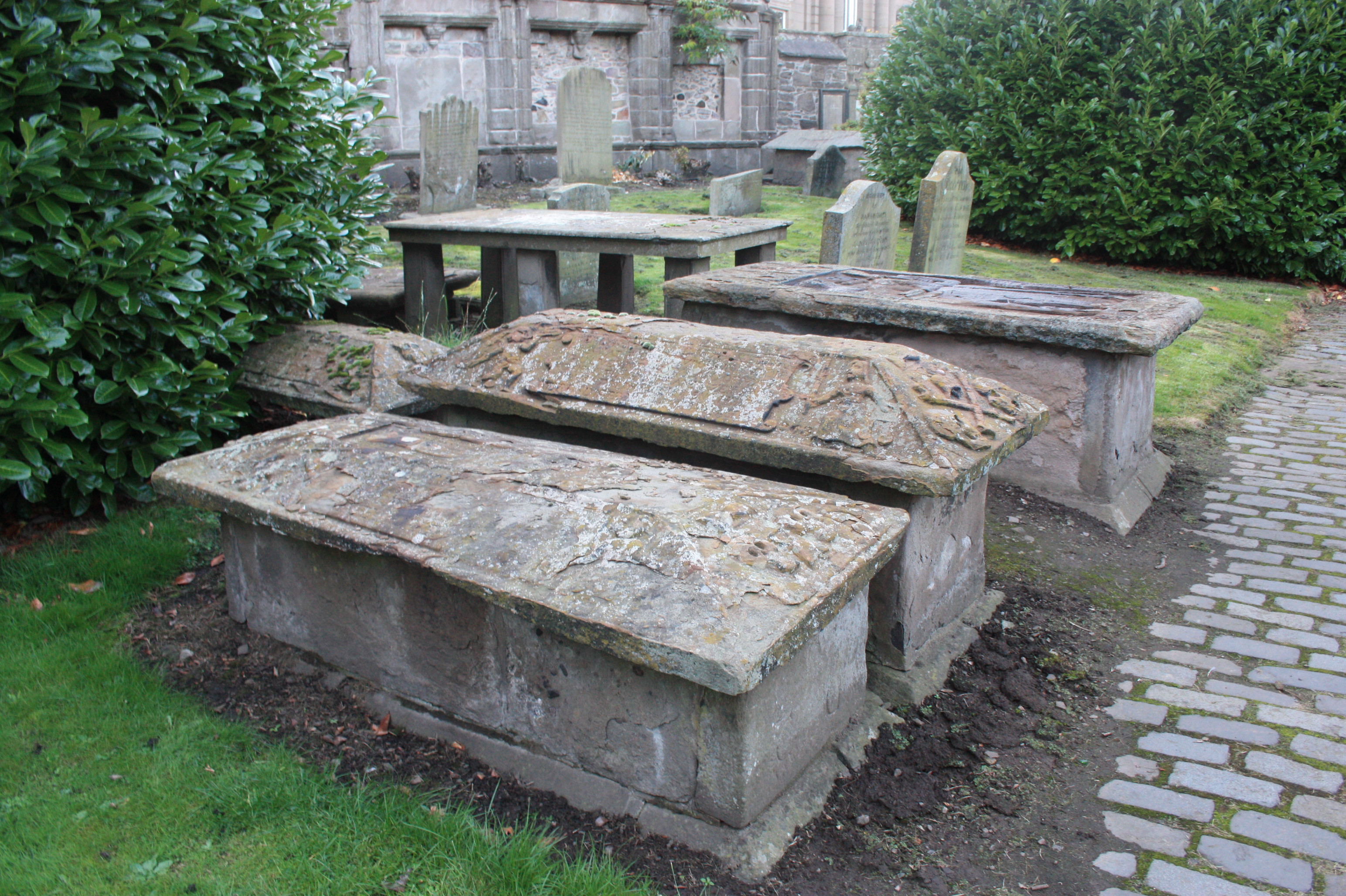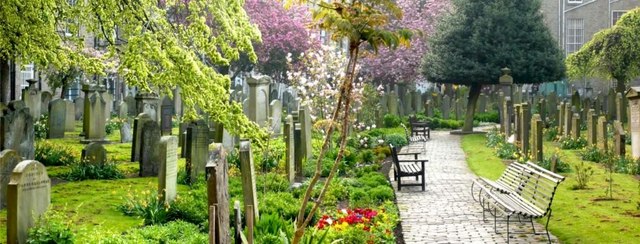The Howff on:
[Wikipedia]
[Google]
[Amazon]


 The Howff is a
The Howff is a
 The land of the burial ground was part of the Franciscan (Greyfriars) Monastery until the Scottish Reformation. In 1564 Mary, Queen of Scots granted the land to the
The land of the burial ground was part of the Franciscan (Greyfriars) Monastery until the Scottish Reformation. In 1564 Mary, Queen of Scots granted the land to the
 Burials at The Howff include:
* Alexander Bell (1776–1852), surgeon
* Samuel Bell (1739-1813) town architect
* Thomas Bell (1759–1844), Provost of Dundee
* James Chalmers (1782–1853), printer, bookseller and inventor of the adhesive postage stamp
* Sir Alexander Douglas of Glenbervie (1738–1812)
* George Duncan (1791–1878), politician and last person to be buried in the Howff
* George Forrester (1635–1675), Dean of Guild in Dundee
*
Burials at The Howff include:
* Alexander Bell (1776–1852), surgeon
* Samuel Bell (1739-1813) town architect
* Thomas Bell (1759–1844), Provost of Dundee
* James Chalmers (1782–1853), printer, bookseller and inventor of the adhesive postage stamp
* Sir Alexander Douglas of Glenbervie (1738–1812)
* George Duncan (1791–1878), politician and last person to be buried in the Howff
* George Forrester (1635–1675), Dean of Guild in Dundee
* James Balfour Paul, ''Scots Peerage'', vol iii, p. 17. Edinburgh 1904
Archive.org
* John Lyon (1765–1814), botanist (memorial only)
* John Pitcairn (d.1800), Provost of Dundee
*
Tombs of the Dundee Howff
The Howff site record
at Canmore, Historic Environment Scotland * {{DEFAULTSORT:Howff
Cemeteries in Scotland
Category A listed buildings in Dundee
1564 establishments in Scotland
History of Dundee
{{DEFAULTSORT:Howff
Cemeteries in Scotland
Category A listed buildings in Dundee
1564 establishments in Scotland
History of Dundee


 The Howff is a
The Howff is a burial ground
A cemetery, burial ground, gravesite or graveyard is a place where the remains of dead people are buried or otherwise interred. The word ''cemetery'' (from Greek , "sleeping place") implies that the land is specifically designated as a buri ...
in the city of Dundee
Dundee (; sco, Dundee; gd, Dùn Dè or ) is Scotland's fourth-largest city and the 51st-most-populous built-up area in the United Kingdom. The mid-year population estimate for 2016 was , giving Dundee a population density of 2,478/km2 or ...
, Scotland. Established in 1564, it has one of the most important collections of tombstones in Scotland, and is protected as a category A listed building.
The majority of graves face exactly due east.
History
 The land of the burial ground was part of the Franciscan (Greyfriars) Monastery until the Scottish Reformation. In 1564 Mary, Queen of Scots granted the land to the
The land of the burial ground was part of the Franciscan (Greyfriars) Monastery until the Scottish Reformation. In 1564 Mary, Queen of Scots granted the land to the burgh
A burgh is an autonomous municipal corporation in Scotland and Northern England, usually a city, town, or toun in Scots. This type of administrative division existed from the 12th century, when King David I created the first royal burghs. Burg ...
of Dundee, for use as a burial ground. It was used for meetings by the Dundee Incorporated Trades, and subsequently became known as The Howff, from the Scots
Scots usually refers to something of, from, or related to Scotland, including:
* Scots language, a language of the West Germanic language family native to Scotland
* Scots people, a nation and ethnic group native to Scotland
* Scoti, a Latin na ...
word '' howff'' 'an enclosed open space, yard, area (as a timber yard)', likely related to German or Dutch ''hof'' 'enclosed space, courtyard'. Old parish records for burials within The Howff begin in the late 18th century. Prior to this records of mortcloth
A pall (also called mortcloth or casket saddle) is a cloth that covers a casket or coffin at funerals. The word comes from the Latin ''pallium'' (cloak), through Old English. A pall or palla is also a stiffened square card covered with white lin ...
hire, a cloth rented out by the Guildry and Trades to cover bodies or coffins before burial, provide evidence of burials dating back to 1655. Meetings at The Howff ceased in 1776. The last burial took place in 1878 (George Duncan). The walls along the west side date from 1601.
The vault to the extreme south west (now simply saying "Blackness" inside) was the burial Vault of the Wedderburns of Blackness House in Dundee. A sealed window on its exterior appears to indicate this was either a watch-house or part of the original meeting-house prior to the vault being built (c.1630).
The graveyard is highly unusual by Scottish standards, containing a high number of Roman-style coffer tombs. It also contains a high number of inscriptions which philosophise on death itself rather than discussing the person interred.
Of the 80,000 burials in the Howff around 3% are classed as "foreign" but with many simply bearing this label due to birth at sea, reflecting Dundee's maritime heritage. As an odder distinction, some 10% of the deaths are specifically recorded as "Irish burials", largely labourers in the early 19th century.
Burials
 Burials at The Howff include:
* Alexander Bell (1776–1852), surgeon
* Samuel Bell (1739-1813) town architect
* Thomas Bell (1759–1844), Provost of Dundee
* James Chalmers (1782–1853), printer, bookseller and inventor of the adhesive postage stamp
* Sir Alexander Douglas of Glenbervie (1738–1812)
* George Duncan (1791–1878), politician and last person to be buried in the Howff
* George Forrester (1635–1675), Dean of Guild in Dundee
*
Burials at The Howff include:
* Alexander Bell (1776–1852), surgeon
* Samuel Bell (1739-1813) town architect
* Thomas Bell (1759–1844), Provost of Dundee
* James Chalmers (1782–1853), printer, bookseller and inventor of the adhesive postage stamp
* Sir Alexander Douglas of Glenbervie (1738–1812)
* George Duncan (1791–1878), politician and last person to be buried in the Howff
* George Forrester (1635–1675), Dean of Guild in Dundee
* John Glas
John Glas (5 October 1695 – 2 November 1773) was a Scottish clergyman who started the Glasite
The Glasites or Glassites were a small Christian church founded in about 1730 in Scotland by John Glas.John Glas preached supremacy of God's wo ...
(1695–1773), clergyman and founder of the Glasite movement
* Clementina Stirling Graham
Clementina Stirling Graham (1782–1877), of Duntrune, was a Scottish hostess and author, known for her ''Mystifications.'' Her portrait hangs in the Scottish National Portrait Gallery.
Life
Clementina, born in May 1782, was the elder daughte ...
(1782–1877), Scottish hostess and author
* James and Janet Keiller (1737–1813), creators of Keiller's marmalade
Keiller's marmalade is named after its creator James and Janet Keiller (nee Mathewson, 1737-1813), and is believed to have been the first commercial brand of marmalade in Great Britain. It was made by James Keiller in Dundee, Scotland, later cr ...
* Baron Jhone Kynnier (John Kinnear) (1511–1584)
* David Lindsay, 1st Earl of Crawford (c.1360–1407), interred in the now destroyed pre-reformation Greyfriars kirkArchive.org
Alexander Riddoch
Alexander Riddoch DL (1745–1822) was a Scottish merchant who served eight non-consecutive terms as Provost of Dundee. His nicknames included the "Old Hawk". "The Gudeman of Blacklunans" and "Archdeacon of the Self-Elected".
In his role i ...
(1744–1822), eight times Provost of Dundee
* John Scrymsour (sic) (1611–1657), Provost of Dundee
* The Wedderburn and Ogilvy-Wedderburn baronets
The Wedderburn, later Ogilvy-Wedderburn Baronetcy, of Balindean in the County of Perth, is a title in the Baronetage of the United Kingdom created in 1803.
Balindean
The place-name associated with the baronetcy is Balindean; the place itself is ...
of Balindean (multiple graves)
The New Howff
In 1834 a new cemetery, which was known as the New Howff, was opened on what was then the northern edge of the town on the lower slopes of Dundee Law. This cemetery, which was influenced by Glasgow Necropolis, was more or less destroyed by later building works. Firstly the construction of Dundee's innerring road
A ring road (also known as circular road, beltline, beltway, circumferential (high)way, loop, bypass or orbital) is a road or a series of connected roads encircling a town, city, or country. The most common purpose of a ring road is to assist i ...
in the 1960s cut through the site, and this was followed by the erection of a multi-storey car park over the New Hoff's southern end. Some grave stones were saved and positioned against its western wall which had originally been the boundary between the cemetery and the Dundee and Newtyle Railway.
References
External links
Tombs of the Dundee Howff
The Howff site record
at Canmore, Historic Environment Scotland *
 {{DEFAULTSORT:Howff
Cemeteries in Scotland
Category A listed buildings in Dundee
1564 establishments in Scotland
History of Dundee
{{DEFAULTSORT:Howff
Cemeteries in Scotland
Category A listed buildings in Dundee
1564 establishments in Scotland
History of Dundee